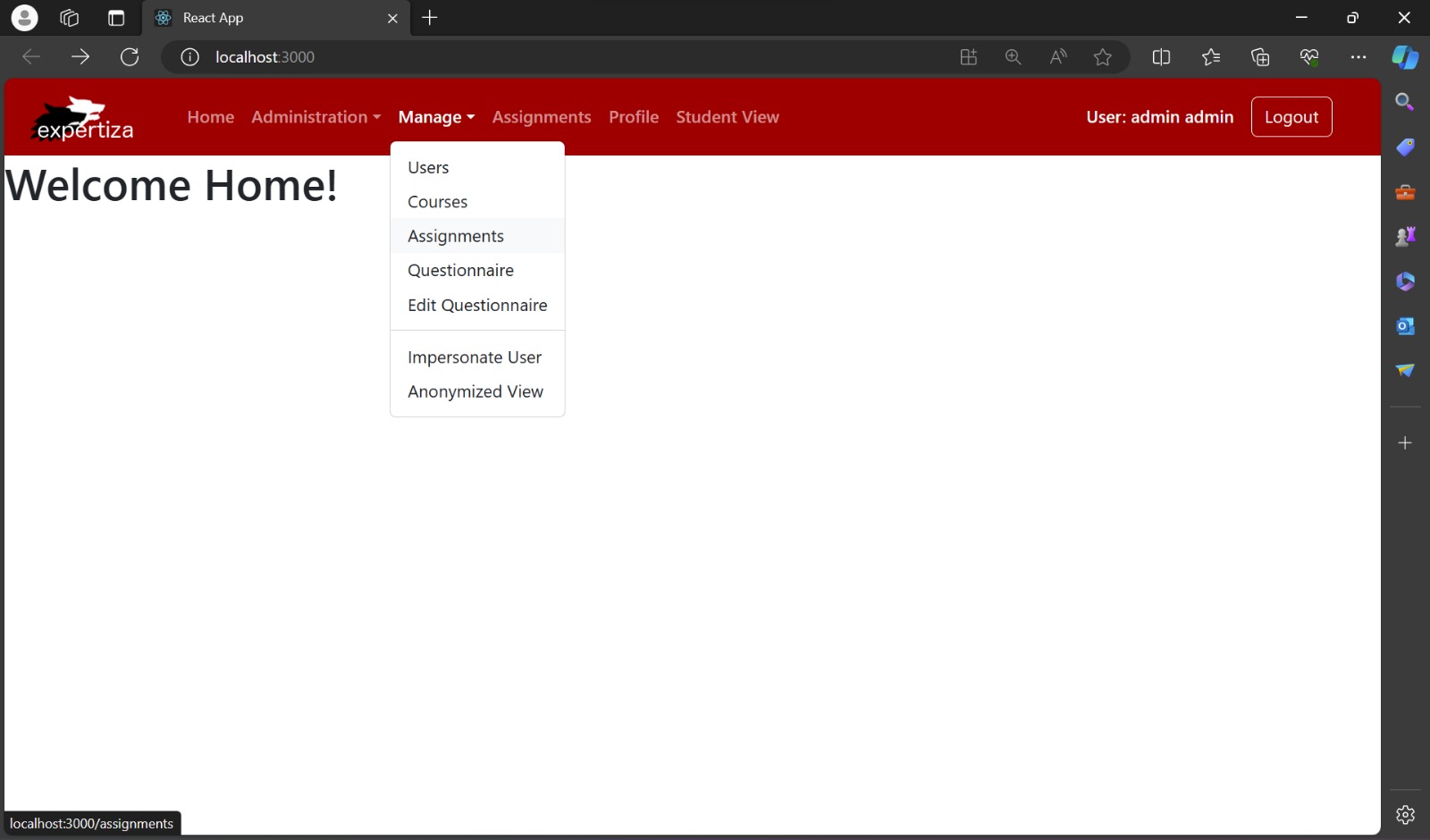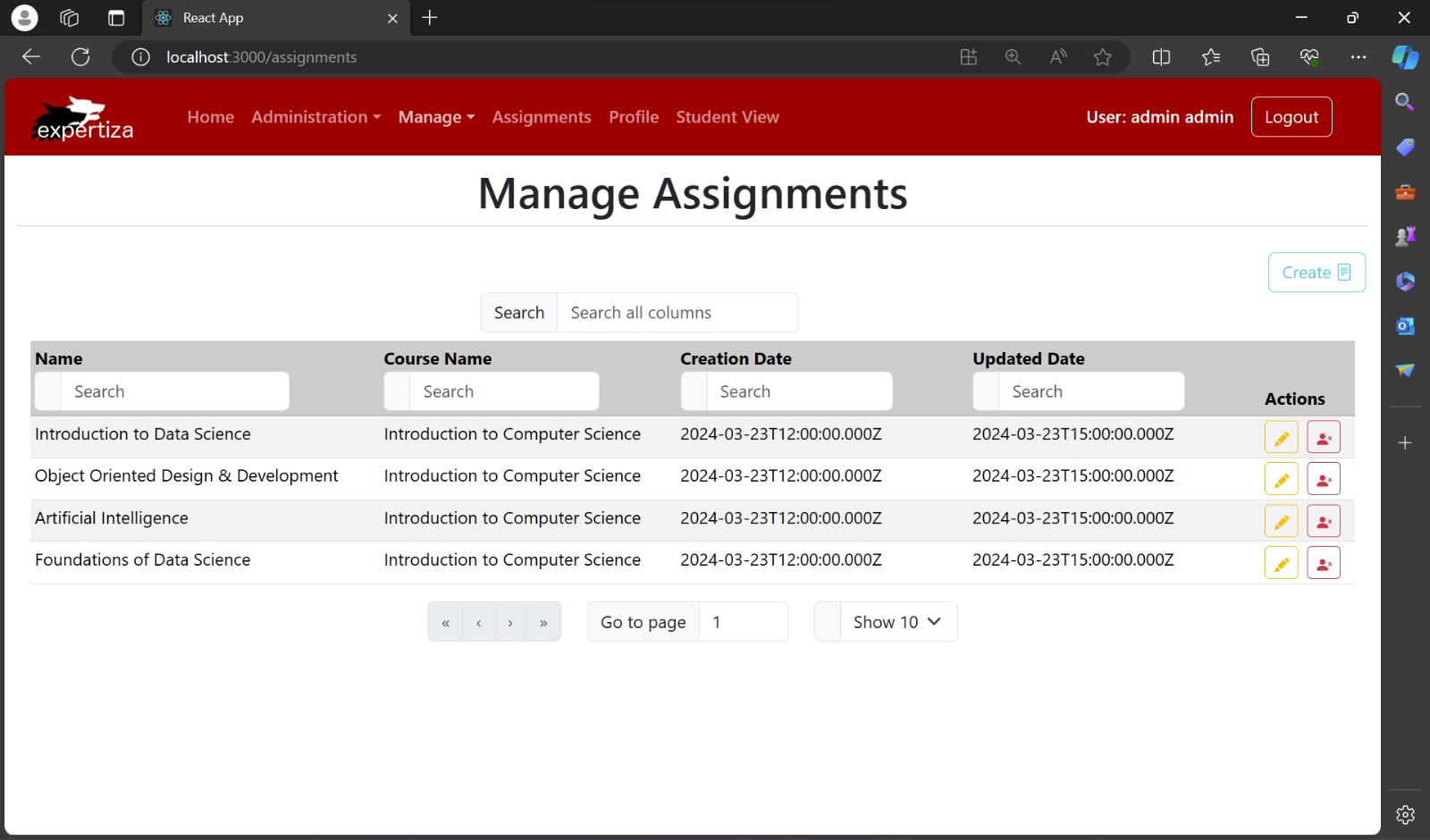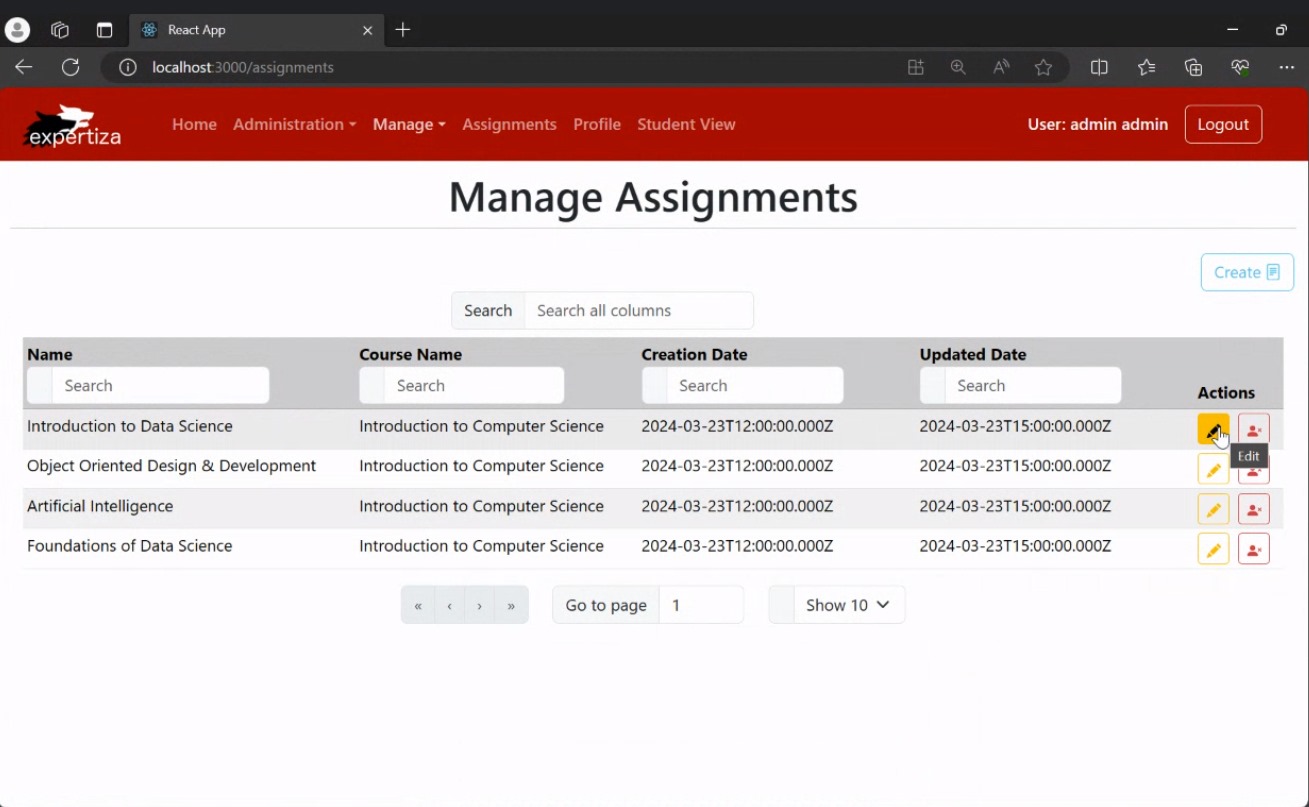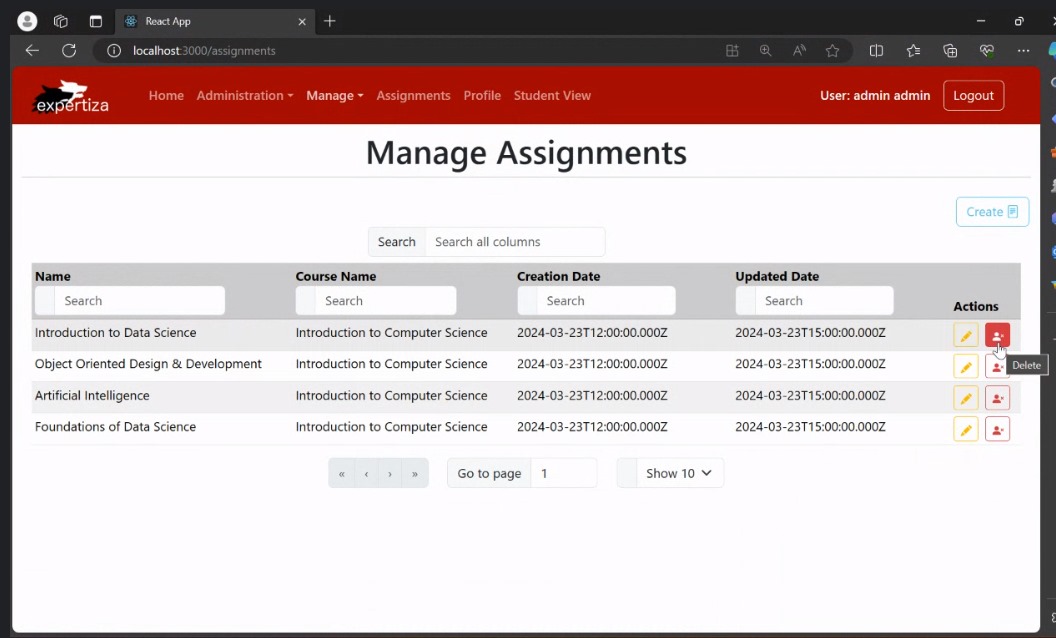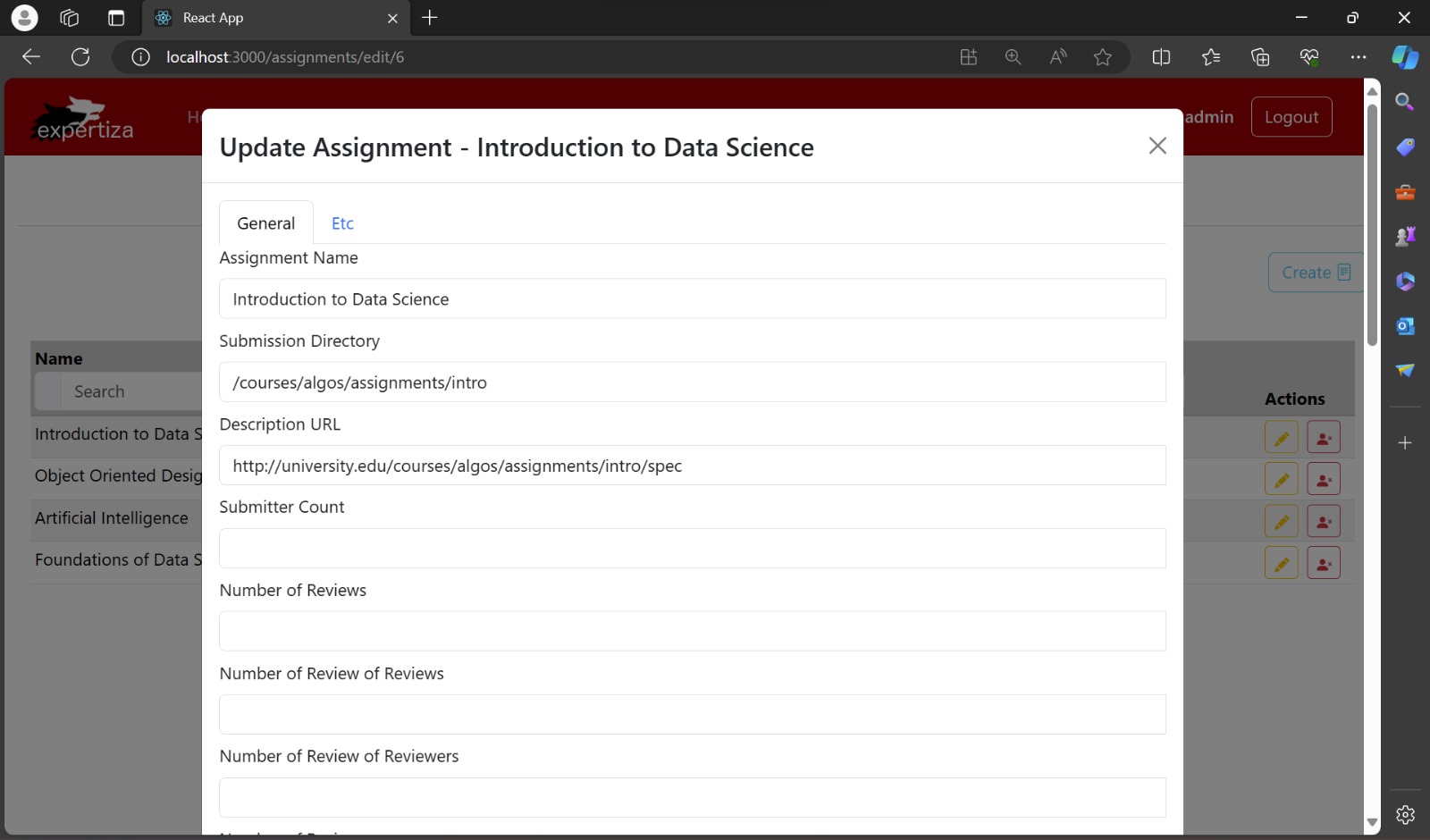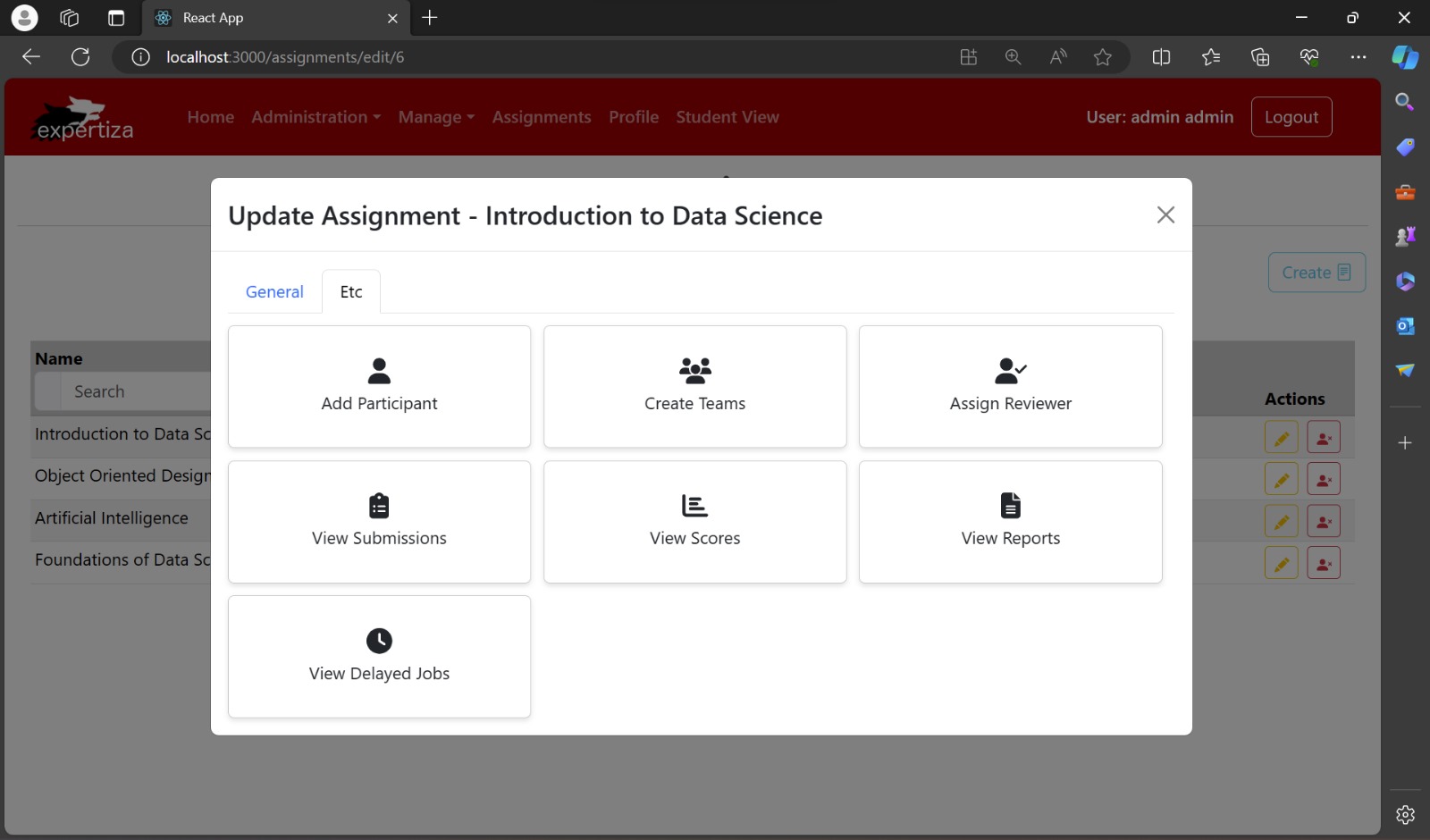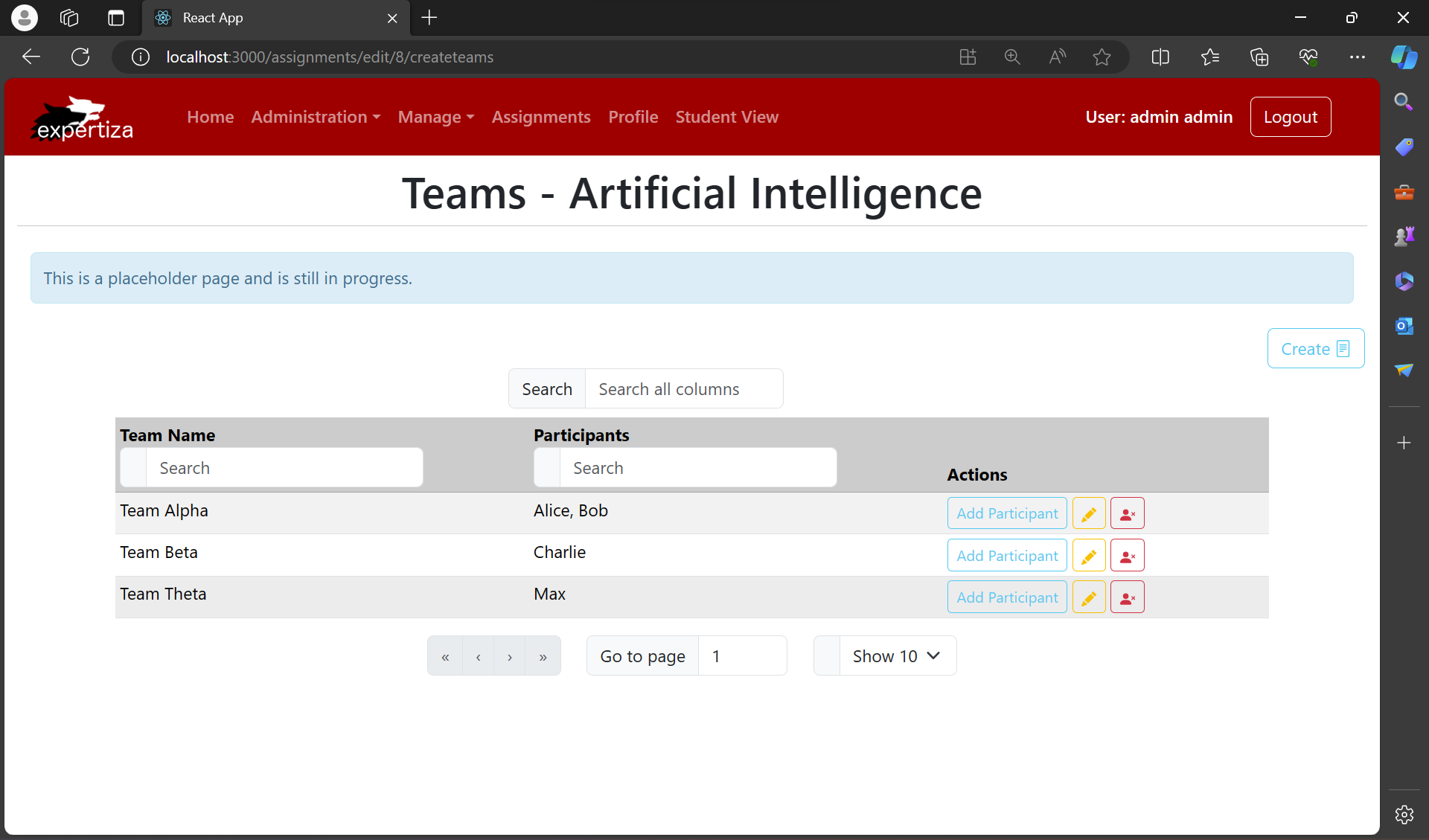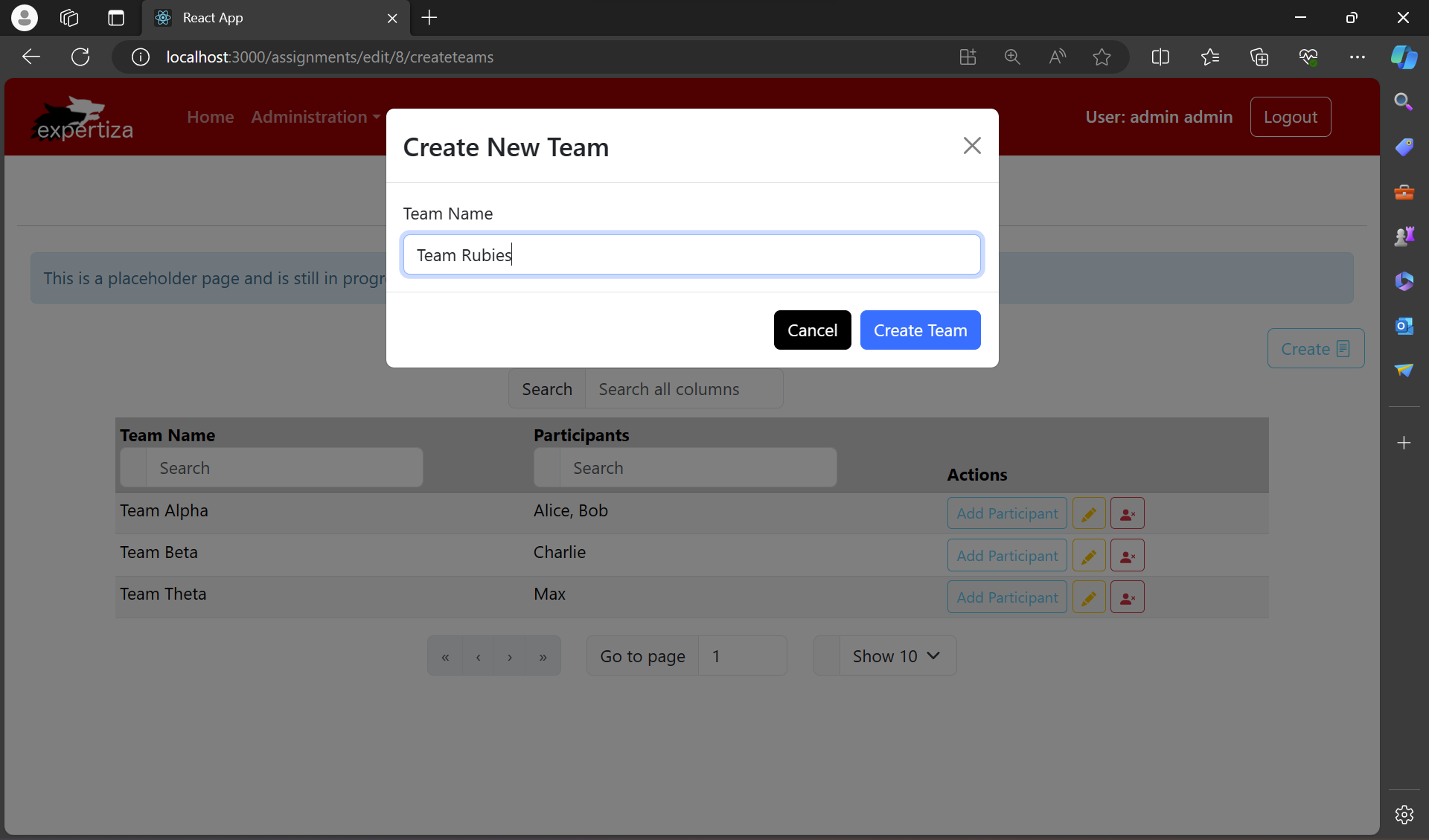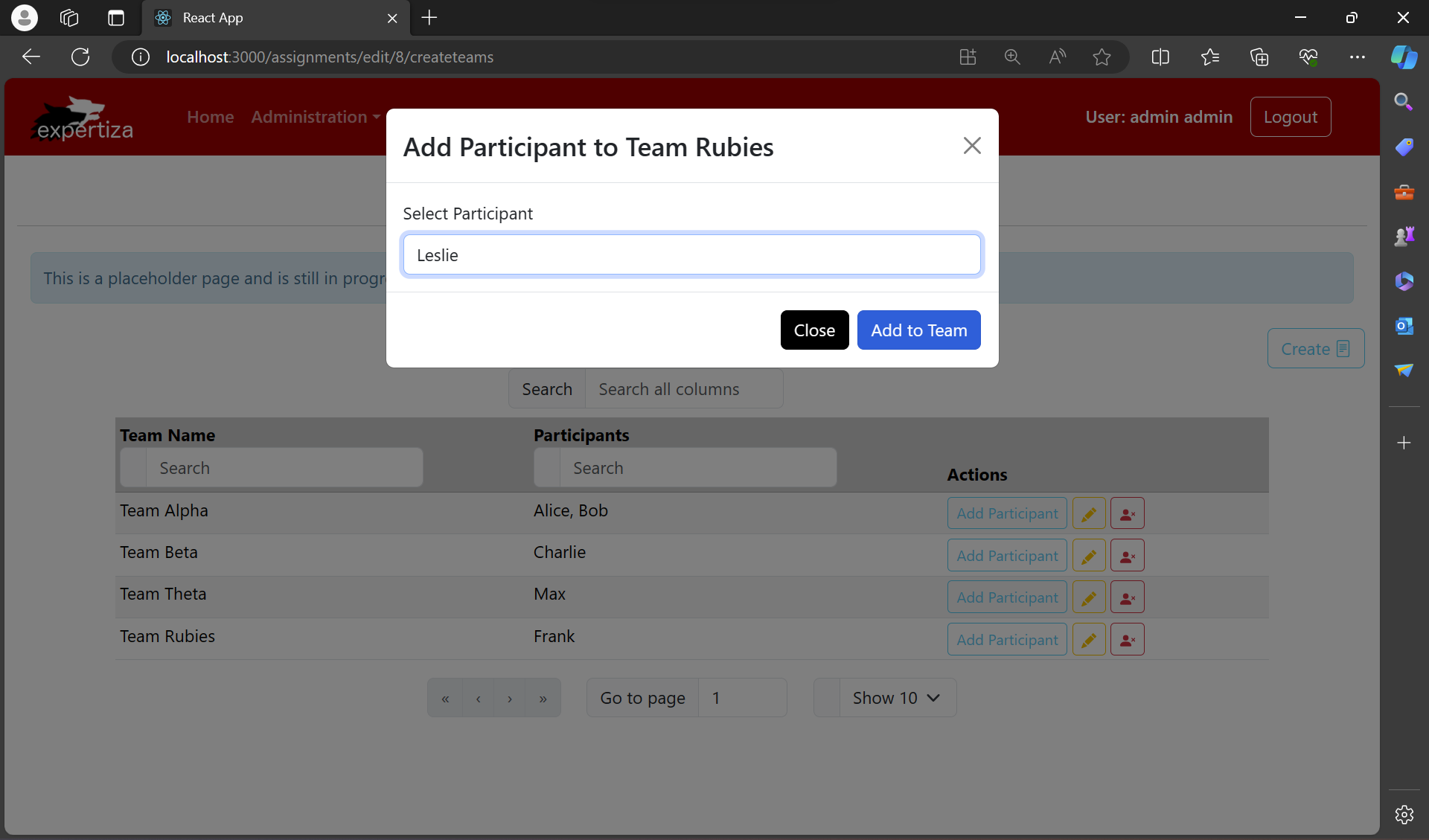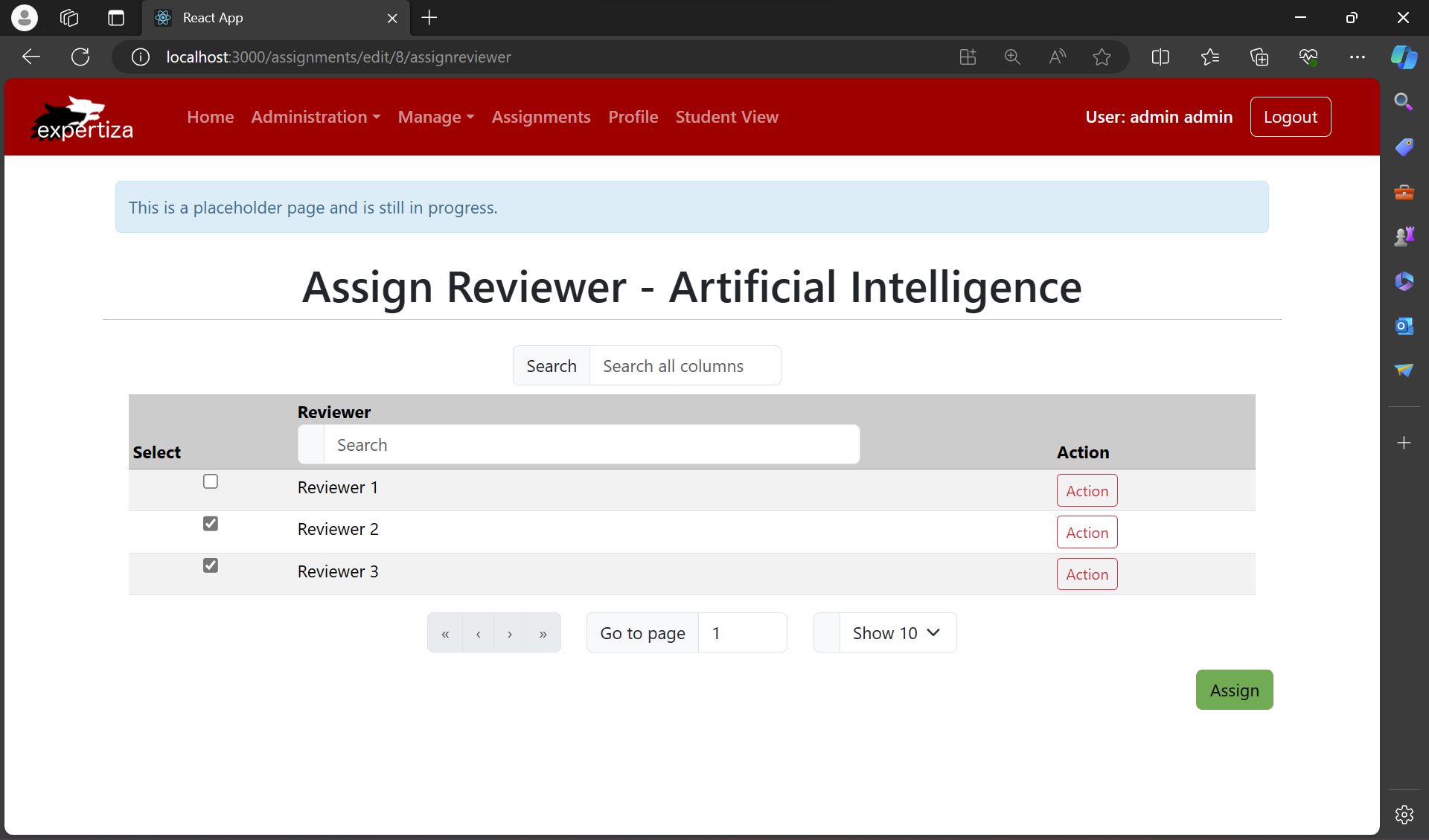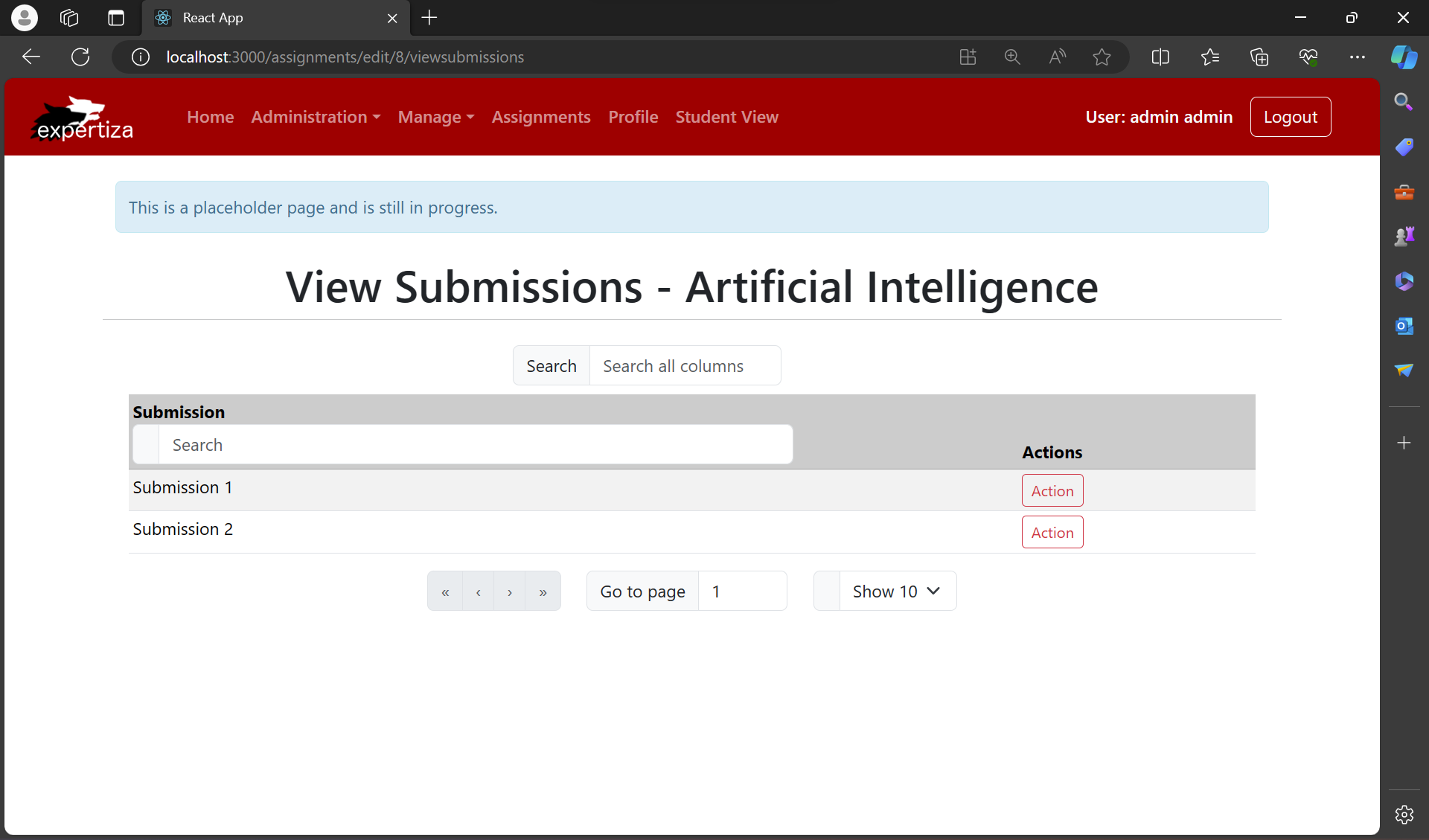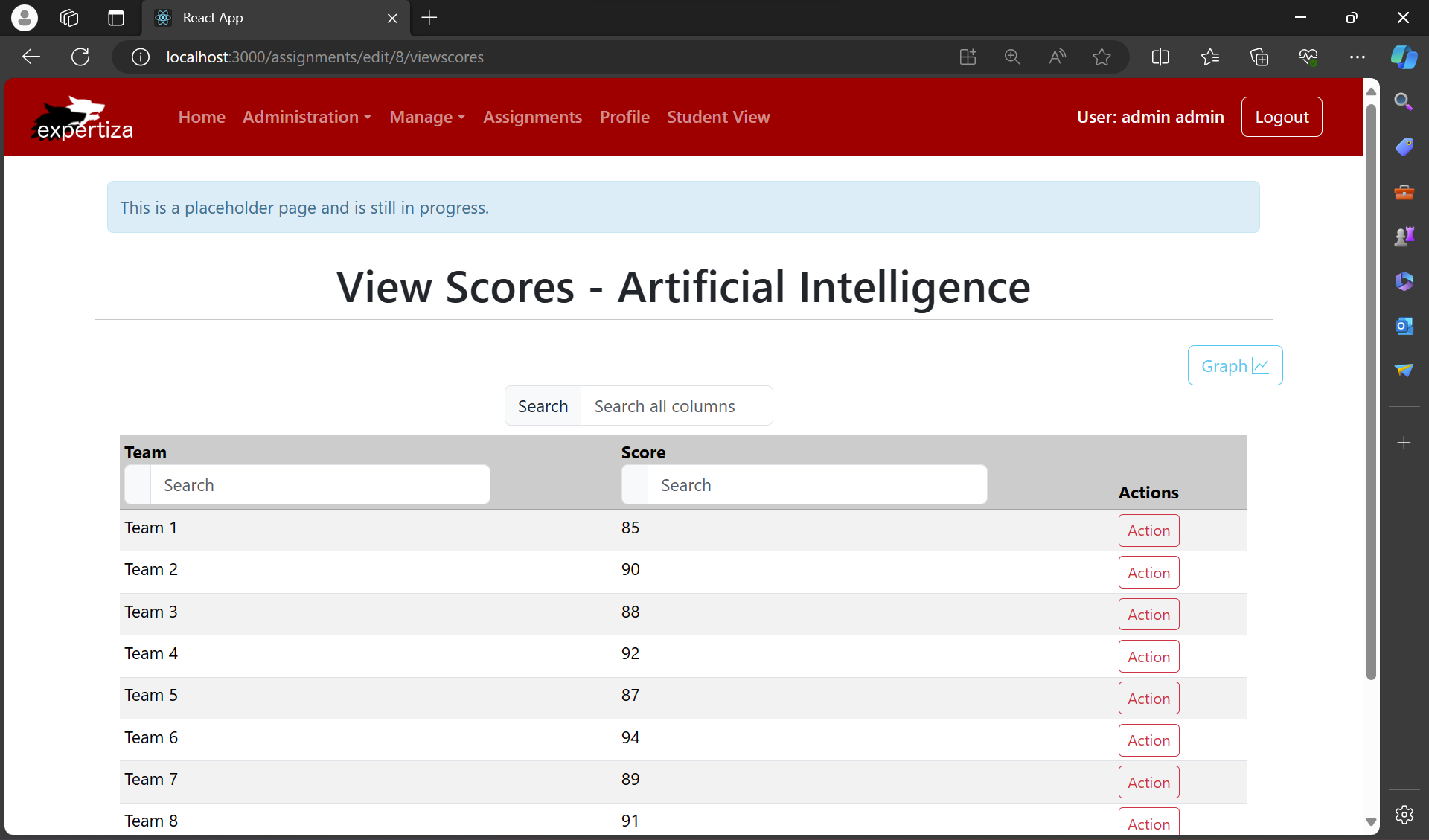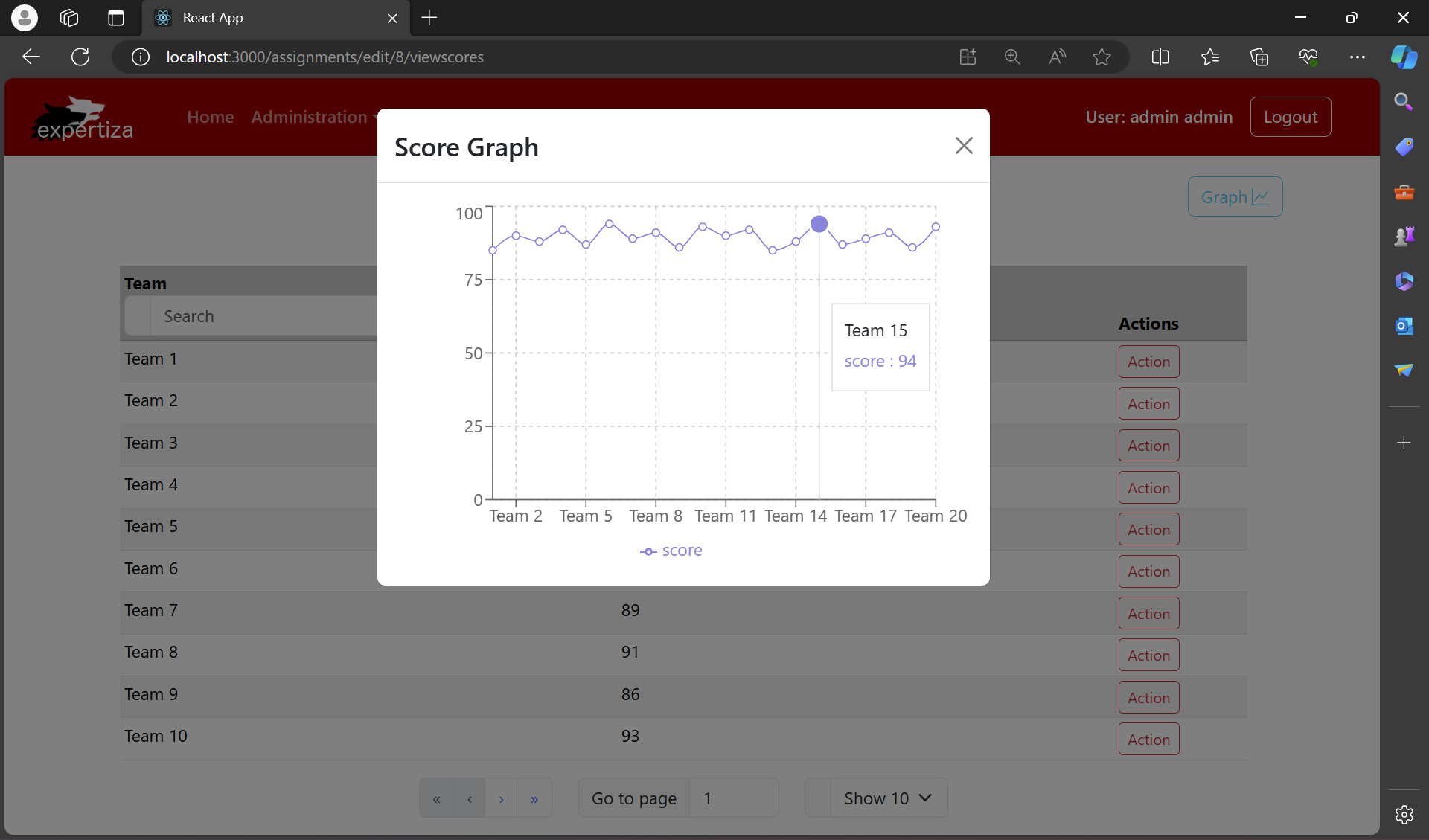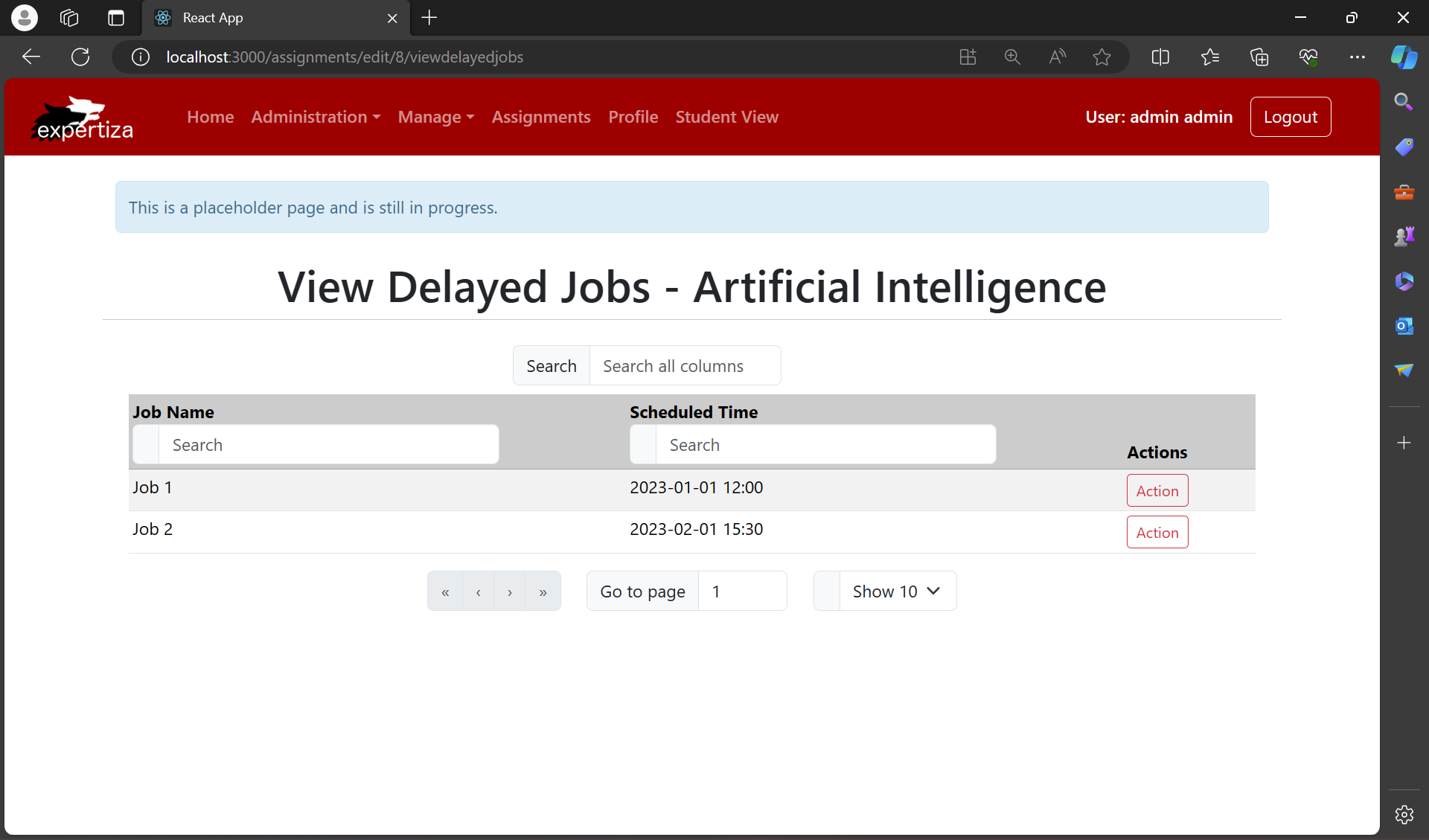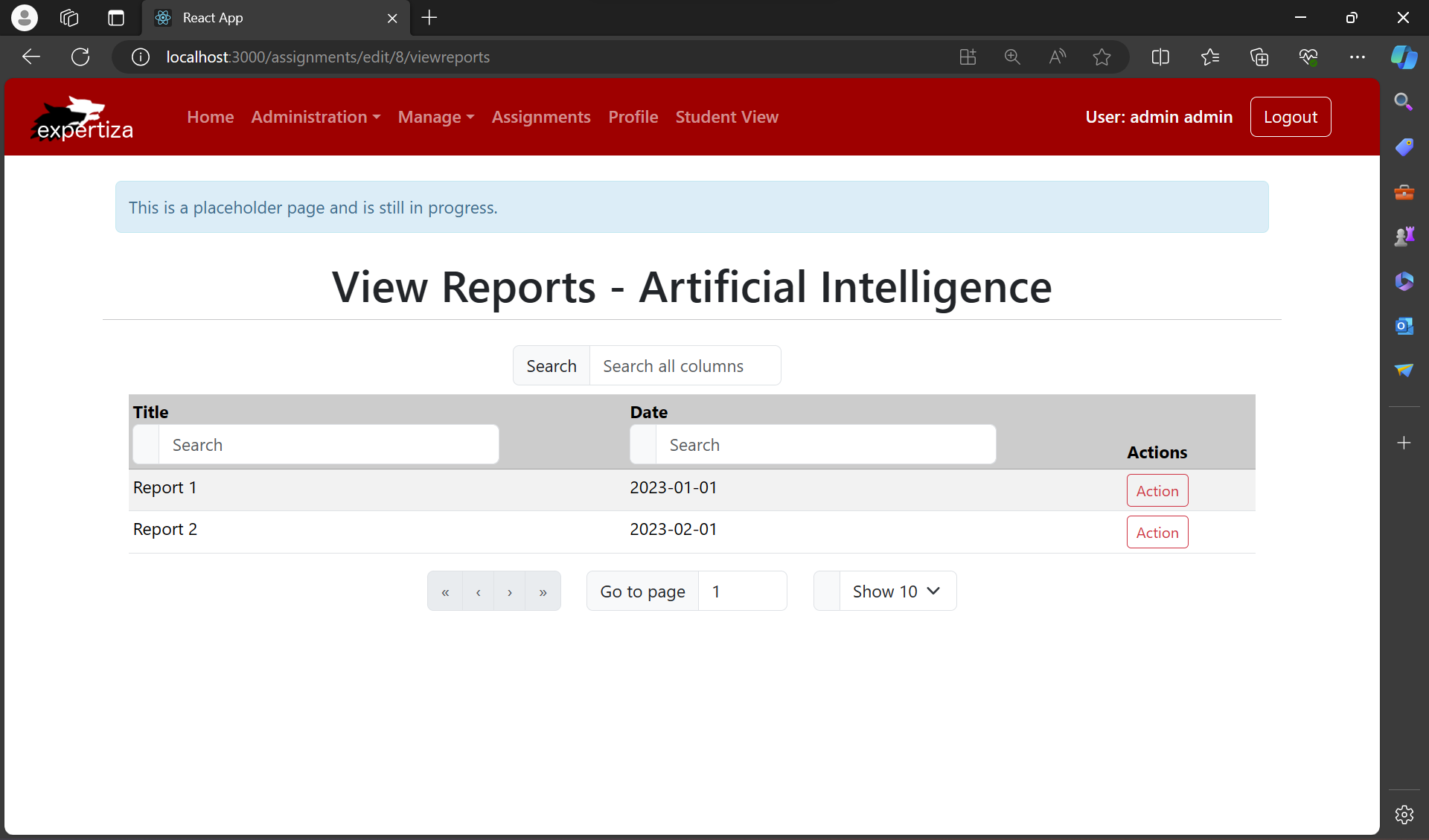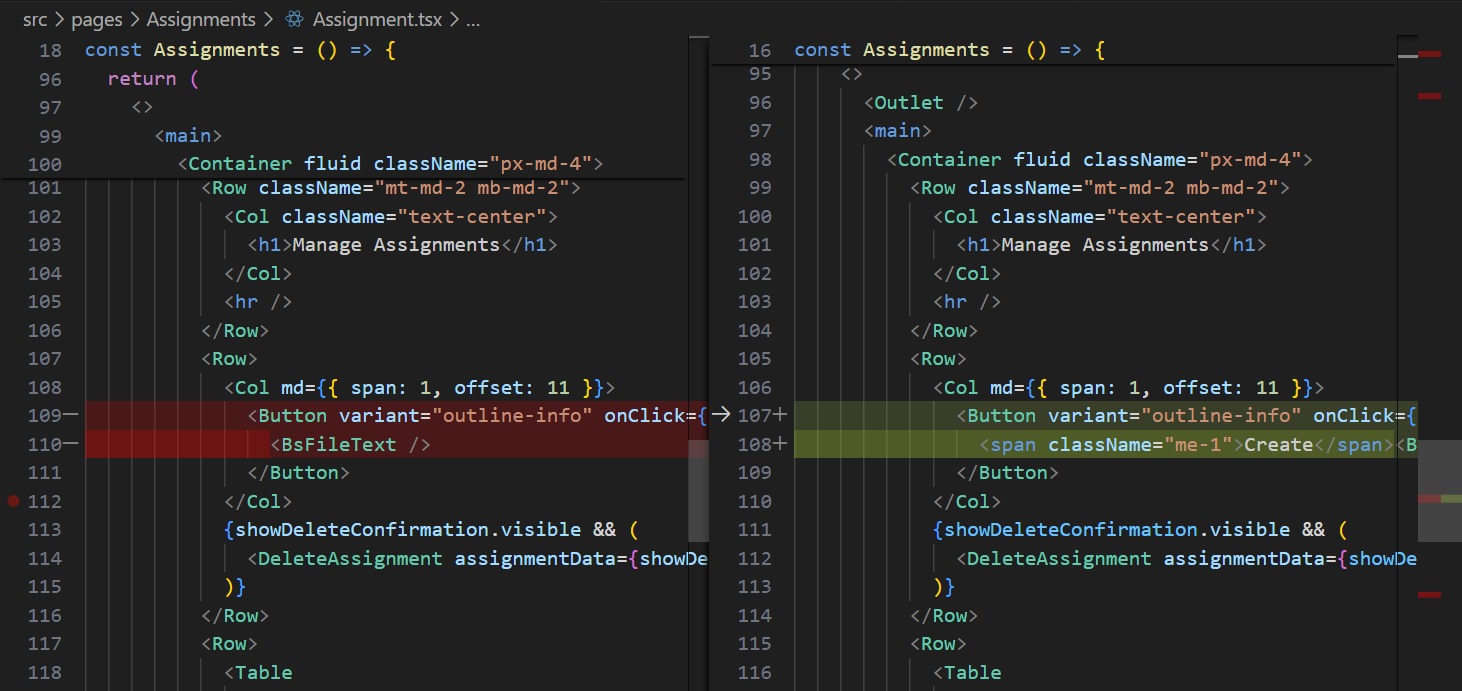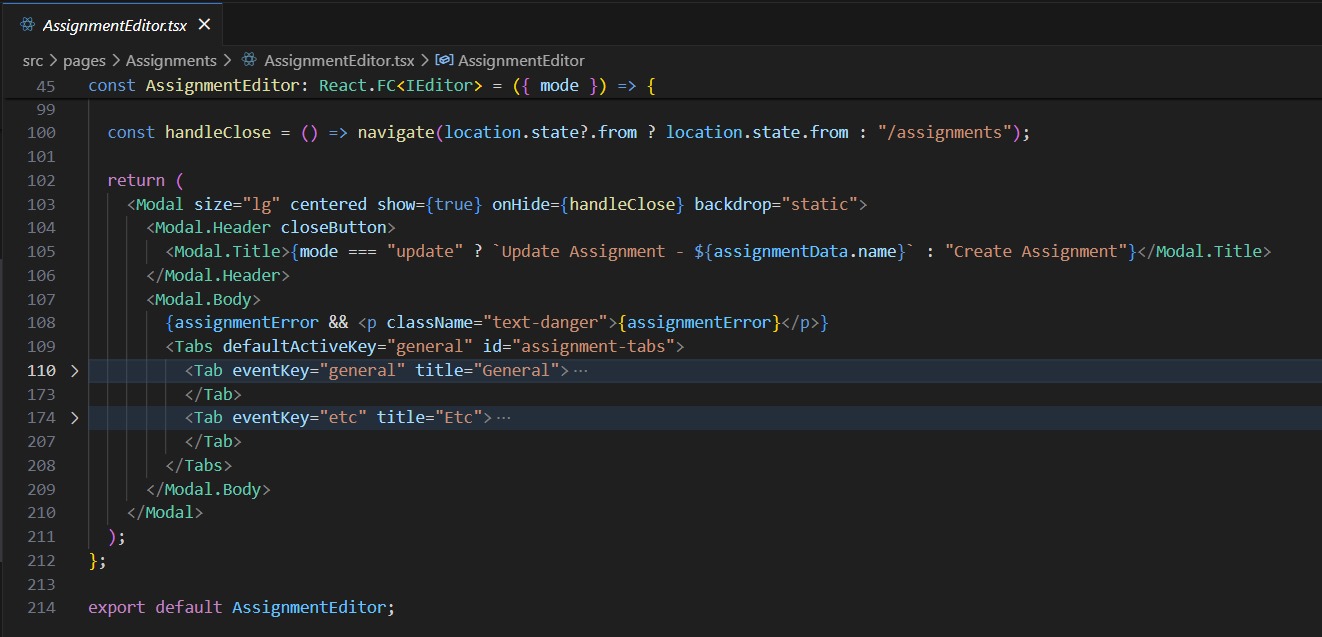CSC/ECE 517 Spring 2024 - E2426. Create a UI for Assignment Edit page "Etc" tab in ReactJS: Difference between revisions
| Line 103: | Line 103: | ||
(Code File: CreateTeams.tsx) | (Code File: CreateTeams.tsx) | ||
(Route Example: http://localhost:3000/assignments/edit/8/createteams) | (Route Example: http://localhost:3000/assignments/edit/8/createteams) | ||
assignments/edit/8/createteams: The application will route the user to a specific page designed for creating teams for the assignment with an ID of 8. | |||
On the "Create Teams" page, instructors and administrators can form new student groups for collaborative projects and assignments such as Artificial Intelligence within a particular course. This part of the system is engineered to facilitate the organization of students into teams, making it easier to manage collaborative work. With user-friendly controls, the page is expected to offer options to add students to teams and fine-tune the team structure, with straightforward options for editing or deleting teams as needed. The search functionality integrated into the design allows for quick filtering through team names and participants, optimizing the user's ability to manage team configurations efficiently. | On the "Create Teams" page, instructors and administrators can form new student groups for collaborative projects and assignments such as Artificial Intelligence within a particular course. This part of the system is engineered to facilitate the organization of students into teams, making it easier to manage collaborative work. With user-friendly controls, the page is expected to offer options to add students to teams and fine-tune the team structure, with straightforward options for editing or deleting teams as needed. The search functionality integrated into the design allows for quick filtering through team names and participants, optimizing the user's ability to manage team configurations efficiently. | ||
Revision as of 01:41, 25 March 2024
Expertiza
Expertiza is a web application designed to facilitate collaborative learning and peer review in educational settings. Built on the Ruby on Rails framework, it offers a versatile platform for both instructors and students. Instructors can seamlessly create and manage assignments and projects, edit them as needed, and review as well as grade student submissions. Students, on the other hand, use Expertiza to form teams, collaborate on various assignments and projects, submit their work, and engage in peer reviews of other students' submissions. This interactive approach not only streamlines the educational process but also actively encourages critical thinking, collaboration, and constructive feedback among students, making it a valuable tool in modern education.
Problem Statement
Create an Etc page that displays all the miscellaneous tasks for the Editing Assignment option. Path: Go to Manage -> Assignment -> Edit (pencil icon) -> Etc This UI is good and can be reconstructed similarly but feel free to exercise your creativity while making this page easy to understand and navigate.
Aim
The primary objective of "Expertiza ETC Tab Reimplementation" project is to design and implement an enhanced "Etc" page within the Expertiza platform, focusing on user-friendliness and intuitive navigation while displaying all miscellaneous tasks associated with the Editing Assignment option. This new page, accessible through the path Manage -> Assignment -> Edit -> Etc, aims to streamline the process of managing various ancillary tasks related to assignment editing. The project will retain the essence of the current UI's effectiveness but infuse it with creative improvements to enhance the overall user experience. Key goals include simplifying the interface for easy understanding, ensuring efficient task management, and fostering a more engaging and less cluttered environment for both instructors and students. This endeavor seeks not just to augment the existing functionality but also to provide a more coherent and visually appealing layout that intuitively guides users through their editing tasks.
Previous Implementation
The previous implementation for managing assignments in the Expertiza platform is a table with assignment details and options for filtering and pagination, emphasizing functional simplicity. The Edit Assignment section presents a modal form for updating an assignment, with clear input fields for essential details. The design prioritizes functionality and easy navigation, utilizing a straightforward color scheme and layout that allows for quick edits without leaving the main page.
The previous implementation has the following limitations:
1. Limited styling options: Basic HTML tables have limited styling options compared to modern CSS frameworks. This can make it difficult to create visually appealing and responsive designs.
2. Lack of Dedicated "Etc" Section: There's no visible, dedicated "Etc" section in the current screenshots. Users might find it challenging to locate miscellaneous tasks relevant to editing assignments.
3. Unclear Task Grouping: Without a specific section or clear grouping, miscellaneous tasks could be scattered or mixed with primary tasks, making it difficult for users to prioritize their actions or find less common functionalities.
4. Aesthetics and Creativity: While the existing design is functional, it may lack the creativity that could make the interface more engaging. Aesthetics play a role in the user's experience, and a utilitarian design might not inspire or facilitate the most efficient workflow.
Design Diagram
Design Functionalities
Manage Assignments
(Code File: Assignment.tsx) (Route: http://localhost:3000/assignments)
Upon navigating through the Expertiza interface, an administrator can streamline their management tasks using the comprehensive menu offered under the "Manage" tab. When any of the available options—such as Users, Courses, Assignments, Questionnaire, Edit Questionnaire, Impersonate User, or Anonymized View—are selected, the user is directed to the corresponding editor page. Here, detailed and interactive elements allow for the editing and customization of each element within the system.
For instance, clicking on "Assignments" will open the assignment editor page, where administrators can create new assignments, modify existing ones, or oversee the intricate details associated with each task. This systematized approach ensures that administrative functions are executed with precision and ease, contributing to an organized and efficient educational platform.
Enhanced Clarity for Create Assignment: By adding the word "Create" before the creation icon, users now have a textual clue alongside the iconographic one. This dual indication makes it significantly clearer that clicking this button or icon will initiate the process of creating a new assignment.
Descriptive Hover Effects: We have implemented hover text for both the edit and delete options. When a user moves their cursor over these icons, descriptive text appears, explaining the function of each button. This is particularly user-friendly, as it helps to prevent accidental clicks and makes the interface more intuitive.
Assignment Editor
(Code File: AssignmentEditor.tsx) (Route Example: http://localhost:3000/assignments/edit/8)
/assignments/edit/8: The application will route the user to a specific page designed for editing the assignment with an ID of 8.
The "Edit Assignment" modal has been restructured for enhanced organization and functionality through the introduction of tabs. This method effectively categorizes settings and actions, facilitating a more streamlined user experience.
When any user with required privileges clicks on "Edit Assignment," the "Update Assignment" modal pops up with two distinct tabs: "General" and "Etc."
General Tab
This is where the fundamental aspects of an assignment can be edited. The options here likely include editing the assignment name, description, submission deadlines, and other basic parameters that define the assignment.
ETC Tab
The "Etc" tab, as presented in the interface, serves as a centralized access point for additional management tasks associated with an assignment, in this case, "Introduction to Data Science". This tab is meticulously organized to provide quick access to a suite of functions.
The "Etc" tab includes the following options, each represented as an interactive tile to streamline the management of assignments:
Add Participant: For enrolling new participants into the assignment.
Create Teams: To assemble participants into teams for collaborative work.
Assign Reviewer: To allocate reviewers for assessing submissions.
View Submissions: Allows viewing of all assignment submissions.
View Scores: To inspect and analyze the scores given to submissions.
View Delayed Jobs: For monitoring scheduled tasks that are set to run later.
View Reports: To generate and review reports based on assignment data.
The above options are laid out as clickable tiles, allowing instructors or administrators to navigate directly to the relevant sections for further actions. The design is focused on enhancing user experience by grouping related management features in a visually coherent and interactive manner, facilitating the efficient administration of the course's workflow and tracking.
The design approach for the Etc page embraces both clarity and efficiency, ensuring that each section is distinct and accessible with minimal navigation.
Add Participant
The "Add Participant" section is a direct entry point to include new members in the assignment process. It utilizes pre-existing components, offering a seamless transition from the Etc tab to the actual functionality of adding participants.
For the other sections, each is represented by a newly created JavaScript file.
Create Teams
(Code File: CreateTeams.tsx) (Route Example: http://localhost:3000/assignments/edit/8/createteams)
assignments/edit/8/createteams: The application will route the user to a specific page designed for creating teams for the assignment with an ID of 8.
On the "Create Teams" page, instructors and administrators can form new student groups for collaborative projects and assignments such as Artificial Intelligence within a particular course. This part of the system is engineered to facilitate the organization of students into teams, making it easier to manage collaborative work. With user-friendly controls, the page is expected to offer options to add students to teams and fine-tune the team structure, with straightforward options for editing or deleting teams as needed. The search functionality integrated into the design allows for quick filtering through team names and participants, optimizing the user's ability to manage team configurations efficiently.
When the 'Create' button is clicked, it directs to a modal window where users can create a new team by entering a desired team name. After inputting the name, such as "Team Rubies," the user can confirm the creation of the team by selecting the 'Create Team' button within the modal. This action will add the new team to the existing list of teams displayed on the main interface, thereby updating the team management system with the new addition. The simple and intuitive design of this functionality suggests its purpose is to enable quick and efficient team creation, facilitating smoother collaboration and organization within the assignment.
When the 'Add Participant' button is clicked next to a team's name, a modal appears where you can add new members to that specific team. In the modal, you can select a participant from a list or through a search function, and then add them to the team by clicking 'Add to Team'. This process is designed to make team management straightforward and efficient, seamlessly integrating new members into existing teams without disrupting the flow of the interface.
Assign Reviewer
(Code File: AssignReviewer.tsx) (Route Example: http://localhost:3000/assignments/edit/8/assignreviewer)
The "Assign Reviewer - Artificial Intelligence" page is designed for users with privileges to assign peer reviewers within the Artificial Intelligence assignment framework. This interface presents a streamlined process, displaying a searchable list of reviewers and providing actionable steps to assign them to evaluate submissions. An 'Action' button is likely tied to each reviewer, enabling the user to allocate reviewing responsibilities systematically. Navigational elements at the bottom suggest the ability to manage a large pool of reviewers across multiple pages, while the prominent 'Assign' button indicates the final step to confirm and apply the reviewer assignments. Even in its current placeholder state, the interface hints at a future where managing peer review assignments is both intuitive and efficient.
View Submissions
(Code File: ViewSubmissions.tsx) (Route Example: http://localhost:3000/assignments/edit/8/viewsubmissions)
The "View Submissions" page is envisioned as a platform where submissions for assignments can be viewed and managed. The interface is designed to display a list of submissions, each associated with an 'Action' button, which is likely meant for users with the appropriate permissions to perform tasks such as reviewing or grading these submissions. A search bar is included to facilitate the quick finding of specific entries, enhancing the ease of navigation. While the interface indicates that it is a placeholder and the development is ongoing, the structured layout points toward a future functionality that will allow efficient handling of student submissions for the course.
View Scores
(Code File: ViewScores.tsx) (Route Example: http://localhost:3000/assignments/edit/8/viewscores)
The "View Scores" page is designed to provide a clear and organized overview of the scores assigned to teams within a course. Users can observe the scored performance of each team, streamlined in a tabular format that includes both the team's identifier and its associated score. A search function is embedded to quickly locate specific teams or scores, enhancing the user's ability to efficiently sift through the data. Each row is equipped with an 'Action' button, implying future functionality for further interaction with the team's scores, such as detailed analysis or revisions. Additionally, the presence of a 'Graph' button indicates the intention to implement visual data representation, offering a more comprehensive view of performance metrics across the teams. The page's current status as a placeholder suggests ongoing development, aimed at optimizing the assessment and feedback process in the course.
The actionable 'Graph' button likely toggles the display of this detailed score graph. The score graph provides a graphical visualization of scores, indicating a feature that allows for a visual analysis of team performance. The graph displays score trends across various teams, pinpointing individual scores for deeper insight. Such a visual tool is valuable for identifying patterns, outliers, and overall class performance at a glance, enhancing the understanding of how teams fare in their assignments. This integration of graphical data representation reflects a commitment to providing a multifaceted approach to assessment analysis.
View Delayed Jobs
(Code File: ViewDelayedJobs.tsx) (Route Example: http://localhost:3000/assignments/edit/8/viewdelayedjobs)
The "View Delayed Jobs" page is intended for viewing assignments or tasks that have not been submitted by the designated deadline. It presents a streamlined table listing each job by name alongside its originally scheduled time, indicating when it was due. This interface aids in identifying late submissions and providing essential information at a glance. Users can utilize the search function to swiftly locate specific delayed jobs, optimizing task management. The presence of 'Action' buttons suggests future functionality that may include options to send reminders, extend deadlines, or otherwise manage these overdue tasks. Although the page is labeled as a placeholder, indicating that development is still underway, its design indicates its purpose: to assist in tracking and handling assignments that have not been submitted on time.
View Reports
(Code File: ViewReports.tsx) (Route Example: http://localhost:3000/assignments/edit/8/viewreports)
The "View Reports" page appears to be a designated area for users to access and manage reports related to a specific course or assignment. The interface organizes reports by title and date, with each report having an associated 'Action' button for further interaction, such as viewing detailed analytics or downloading the report. Search functionality is integrated to filter through reports quickly. The current placeholder notice indicates that the page is a work in progress, suggesting that additional features and functionalities which might include analytics on grades, submission rates, or review completion. maybe implemented to enhance the report management process.
Files Modified
- src/App.tsx
- src/custom.scss
- src/pages/Assignments/Assignment.tsx
- src/pages/Assignments/AssignmentColumns.tsx
- src/pages/Assignments/AssignmentEditor.tsx
- src/pages/Participants/Participant.tsx
- src/pages/Assignments/CreateTeams.tsx
- src/pages/Assignments/ViewDelayedJobs.tsx
- src/pages/Assignments/ViewReports.tsx
- src/pages/Assignments/ViewScores.tsx
- src/pages/Assignments/ViewSubmissions.tsx
Components
Assignment.tsx
The code modification in Assignments.tsx introduces the label "Create" alongside the creation icon within a button, improving user clarity. This change enhances the button's intuitiveness by explicitly indicating its purpose, thereby aligning with UI best practices that advocate for the pairing of icons with descriptive text to facilitate user interaction and accessibility.
AssignmentEditor.tsx
AssignmentEditor.tsx is a React component designed for creating and updating assignments within an application. Here's a summarization of its functionality:
State and Effects: It uses hooks like useDispatch, useSelector, useNavigate, and useLocation for Redux state management, navigation, and side effects.
Form Handling: Incorporates Formik for form state management and Yup for validation, ensuring the form inputs for assignment details are managed correctly and validated.
Modal UI: Uses a React Bootstrap Modal to present the form, providing a user-friendly way to create or update assignments.
Tabs for Organization: The component features Tabs to separate assignment details into "General" and "Etc" categories, with the latter including options like "Add Participant," "Create Teams," and "Assign Reviewer."
Dynamic Form Fields: Renders various form inputs and checkboxes for assignment attributes, dynamically populated for updates or initialized for creation.
Iconography: Utilizes FontAwesome icons for a visually intuitive experience, indicating different actions within the "Etc" tab.
API Integration: Sends requests to the server on form submission, with the ability to handle different HTTP methods based on the context (create or update). Feedback and Navigation: Provides feedback to users on successful updates or errors using alert actions and navigates back to the assignments page upon completion or closure of the modal.
CreateTeams.tsx
ViewScores.tsx
ViewSubmission.tsx
ViewReports.tsx
ViewDelayedJobs.tsx
Test Cases for ETC Tab Sections
| Test Case ID | Objective | Steps | Result |
|---|---|---|---|
| TC1 | Verify that the ETC tab is accessible from Manage -> Participants -> Edit. | Log in, navigate to Manage -> Participants -> Edit, and click on the ETC tab. | The ETC tab is accessible and displays the available features. |
| TC2 | Verify that the Participants page is accessible from the ETC tab. | Click on the 'Participants' option in the ETC tab. | The Participants page loads successfully. |
| TC3 | Verify that the Create Teams feature is accessible from the ETC tab for the particular assignment. | Click on the 'Create Teams' option in the ETC tab. | The Create Teams page for the specific assignment loads successfully. |
| TC4 | Verify that a new team can be created successfully. | Access the Create Teams page and create a new team. | The new team is created successfully. |
| TC5 | Verify that an existing team can be edited successfully. | Access the Create Teams page and edit an existing team. | The team is edited successfully. |
| TC6 | Verify that multiple participants can be added to a team. | Access the Create Teams page and add multiple participants to a team. | Multiple participants are added to the team successfully. |
| TC7 | Verify that a team can be deleted successfully. | Access the Create Teams page and delete a team. | The team is deleted successfully. |
| TC8 | Verify that the Assign Reviewers page is accessible for the particular assignment. | Click on the 'Assign Reviewers' option in the ETC tab. | The Assign Reviewers page for the specific assignment loads successfully. |
| TC9 | Verify that the View Submissions page is accessible for the particular assignment. | Click on the 'View Submissions' option in the ETC tab. | The View Submissions page for the specific assignment loads successfully. |
| TC10 | Verify that the View Scores page is accessible for the particular assignment. | Click on the 'View Scores' option in the ETC tab. | The View Scores page for the specific assignment loads successfully. |
| TC11 | Verify that the score graph displays accurate data for all scores. | Access the View Scores page and view the score graph. | The graph accurately displays all scores. |
| TC12 | Verify that the View Reports page is accessible for the particular assignment. | Click on the 'View Reports' option in the ETC tab. | The View Reports page for the specific assignment loads successfully. |
| TC13 | Verify that the View Delayed Jobs page is accessible for the particular assignment. | Click on the 'View Delayed Jobs' option in the ETC tab. | The View Delayed Jobs page for the specific assignment loads successfully. |
| TC14 | Verify that pagination works correctly for all the pages. | Access each page in the ETC tab and navigate through multiple pages using pagination controls. | Pagination allows navigation through different pages, displaying the correct data on each page. |
| TC15 | Verify that the assignment ID is correctly carried in the route for pages accessed from the ETC tab. | Access each page in the ETC tab and check the URL for the correct assignment ID. | The URL for each page contains the correct assignment ID. |
Team
Mentor
- Kalyan Karnati <kkarnat@ncsu.edu>
Members
- Sreenitya Mandava <smandav@ncsu.edu>
- Sree Tulasi Shevva <sshevva@ncsu.edu>
- Yogitha Seela <yseela@ncsu.edu>


